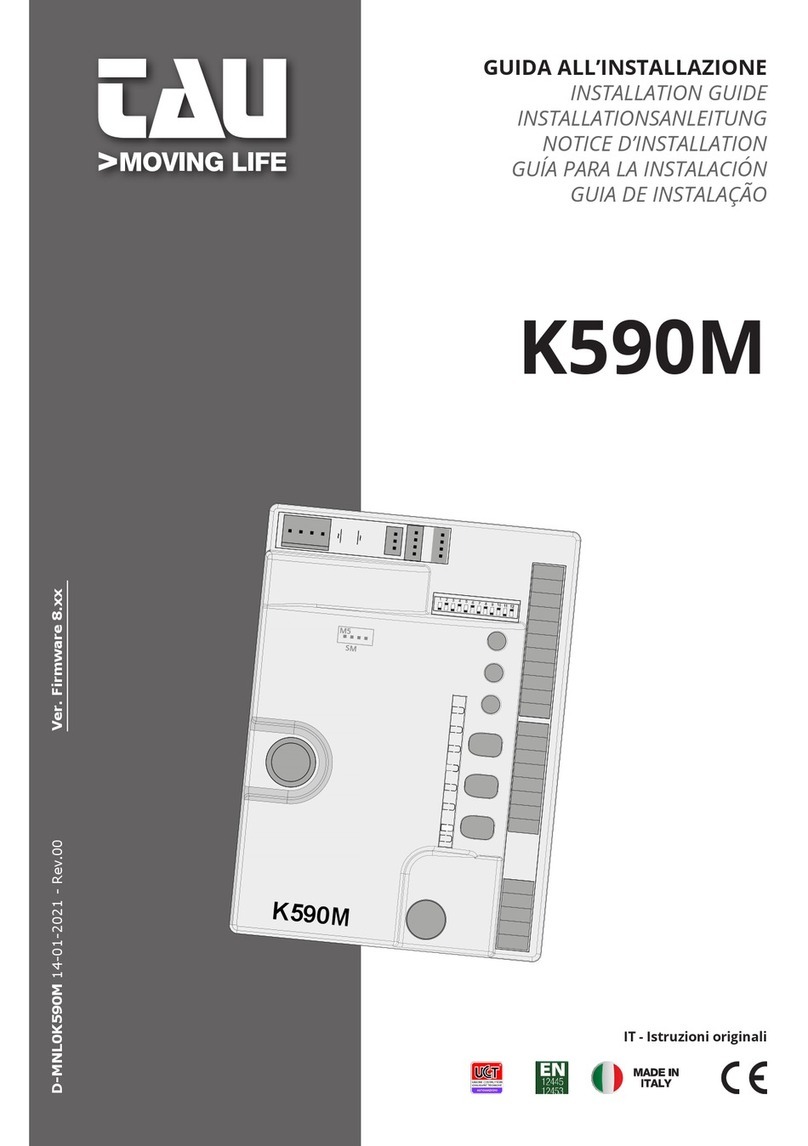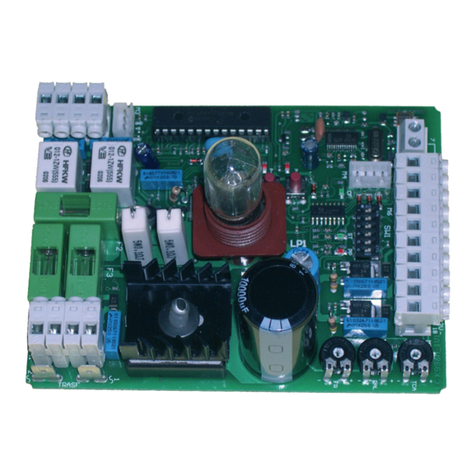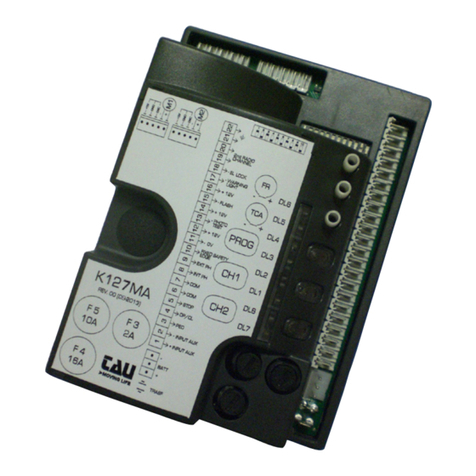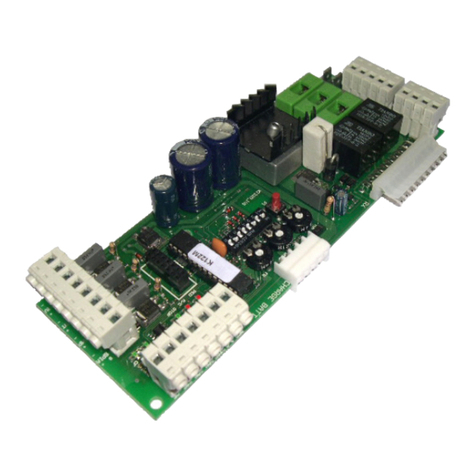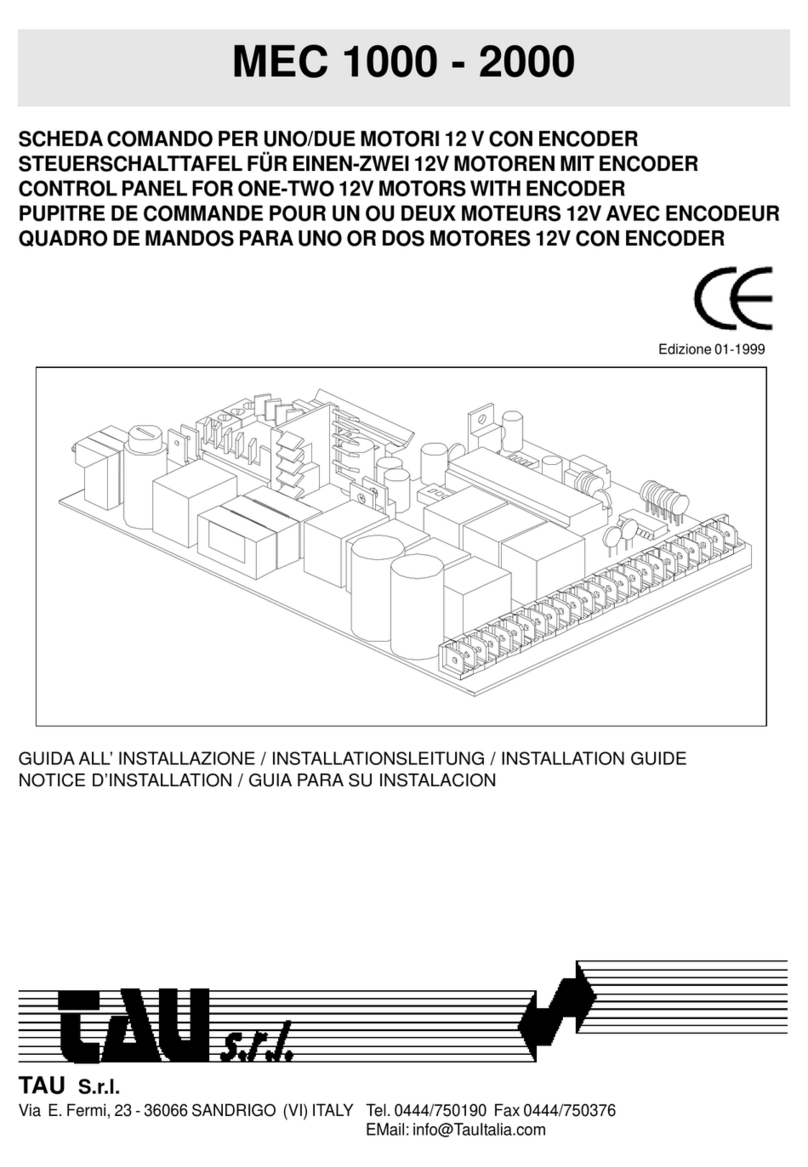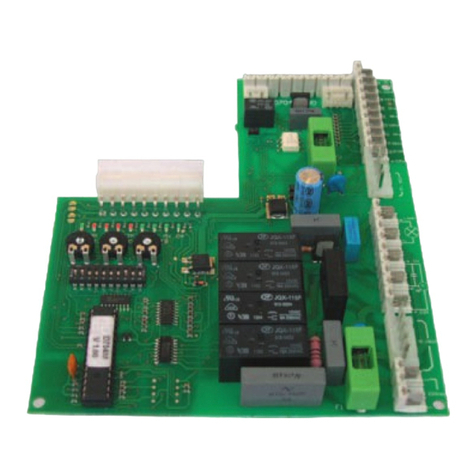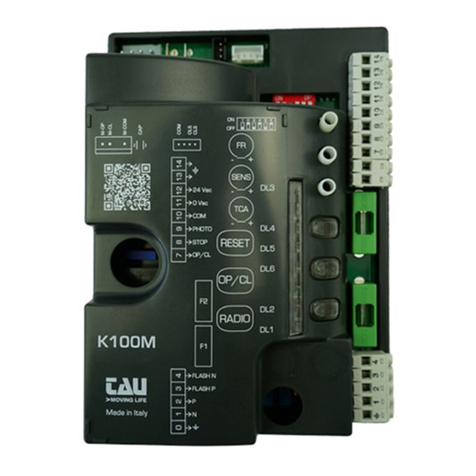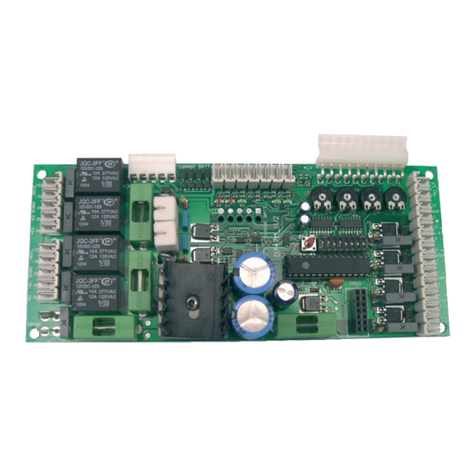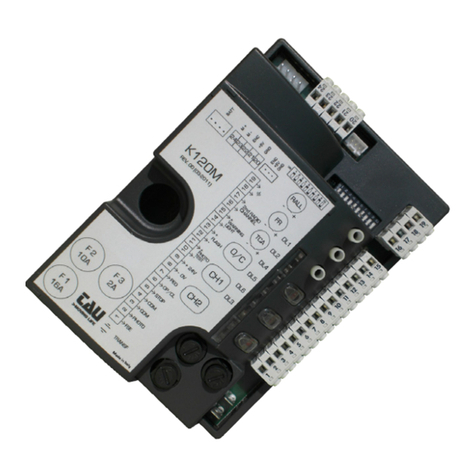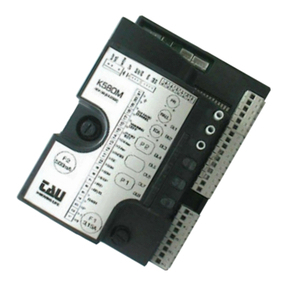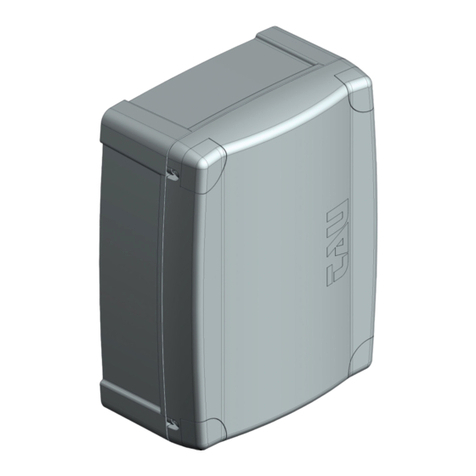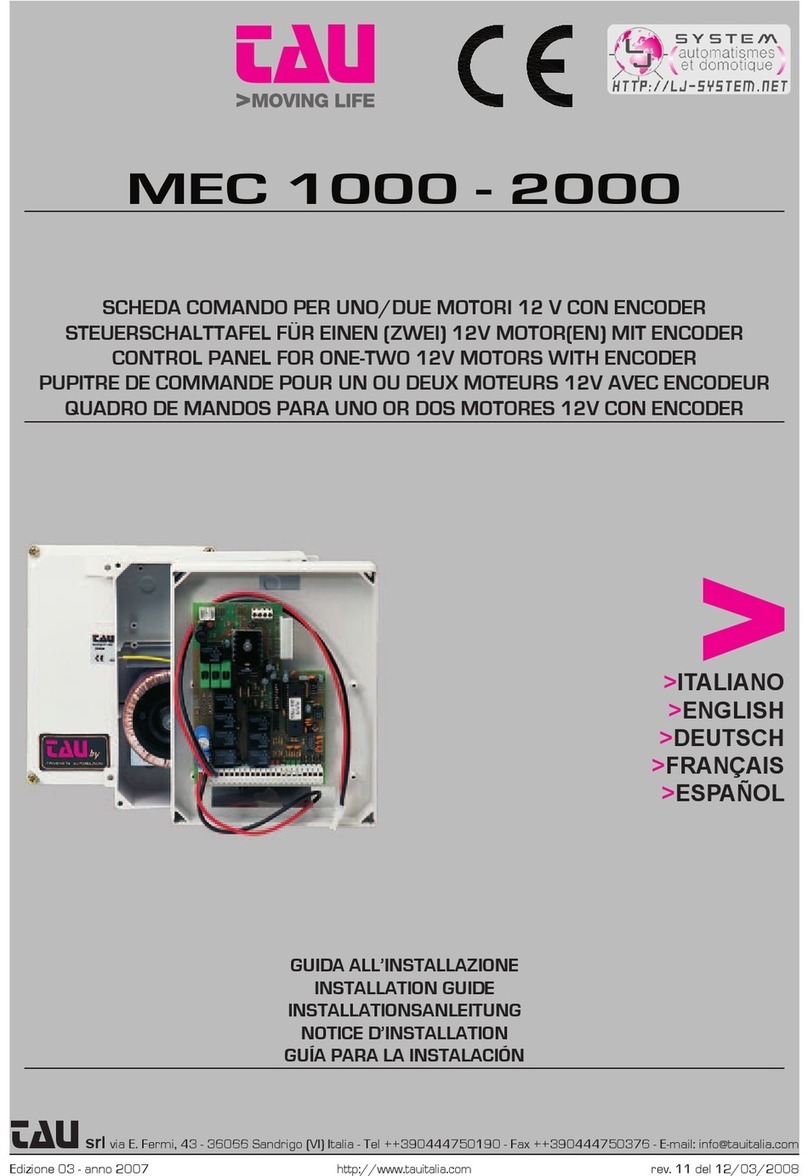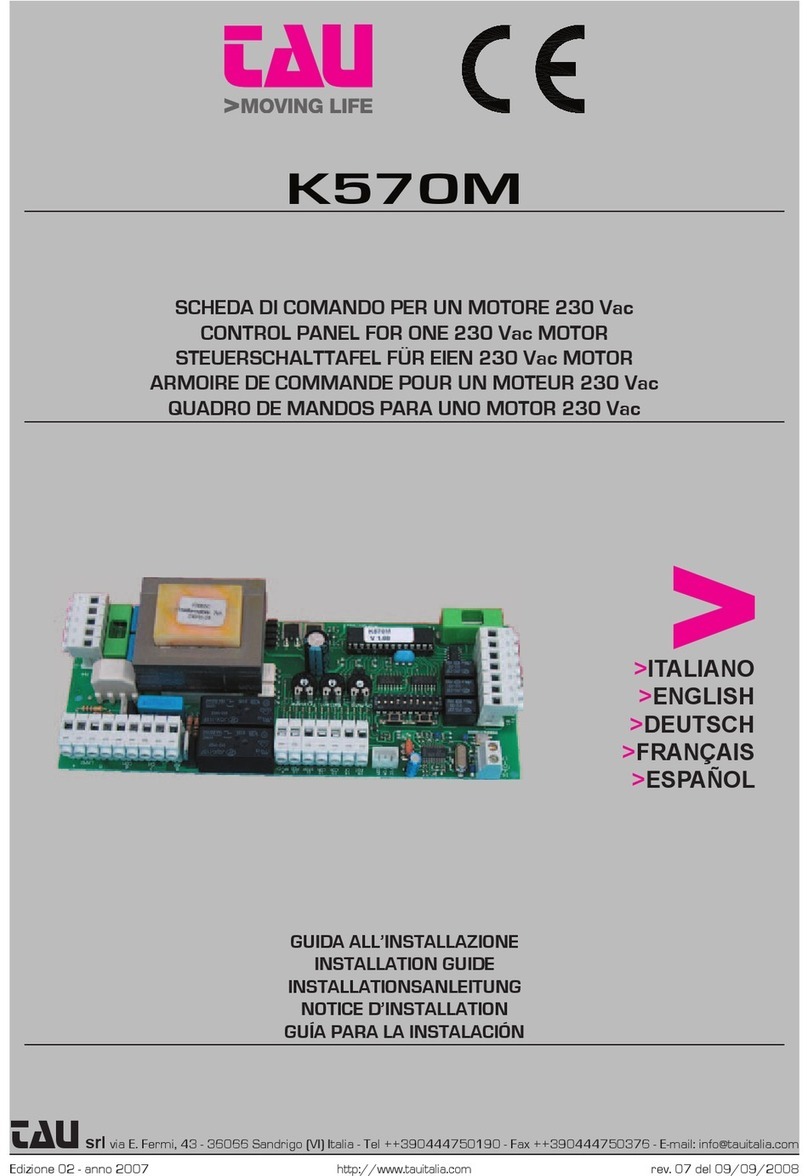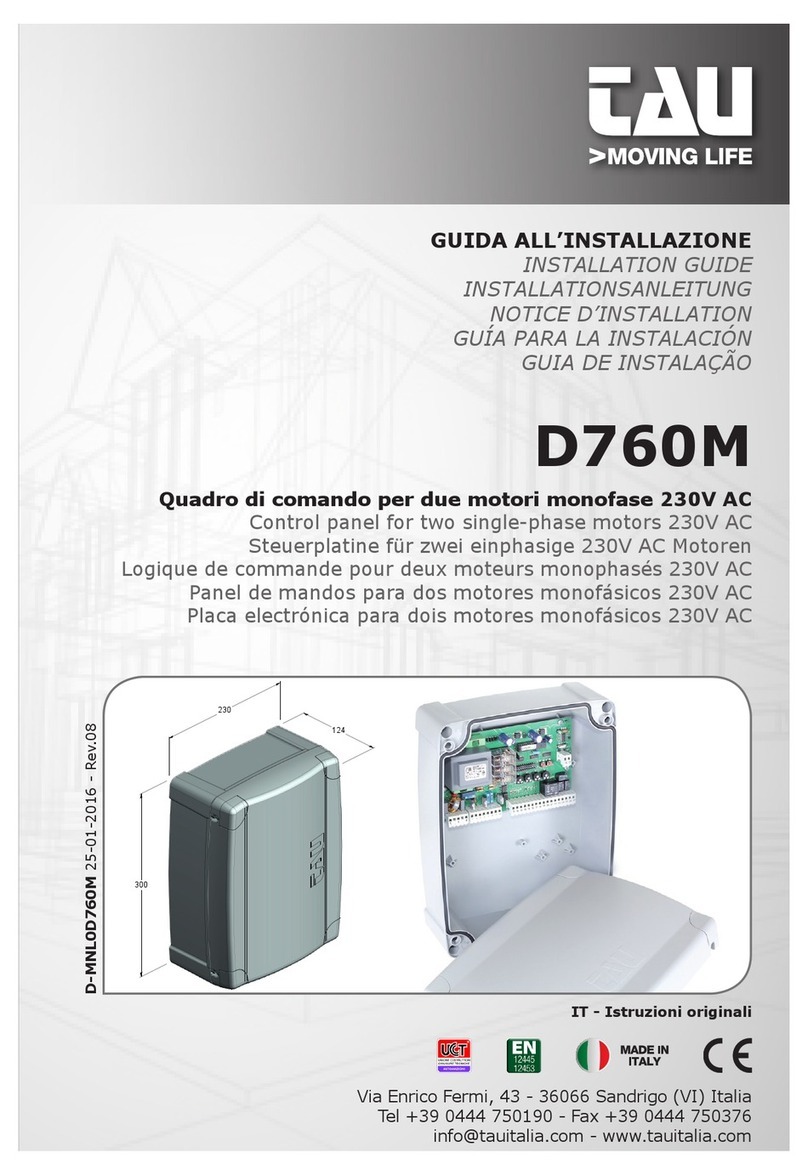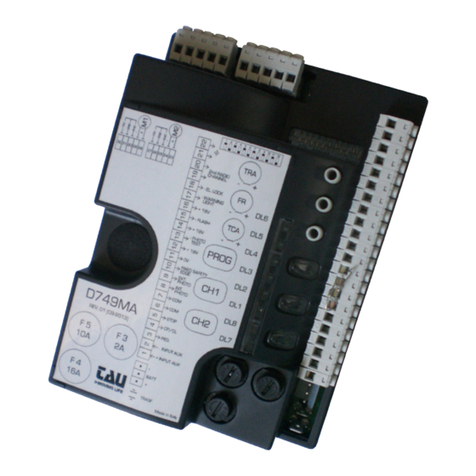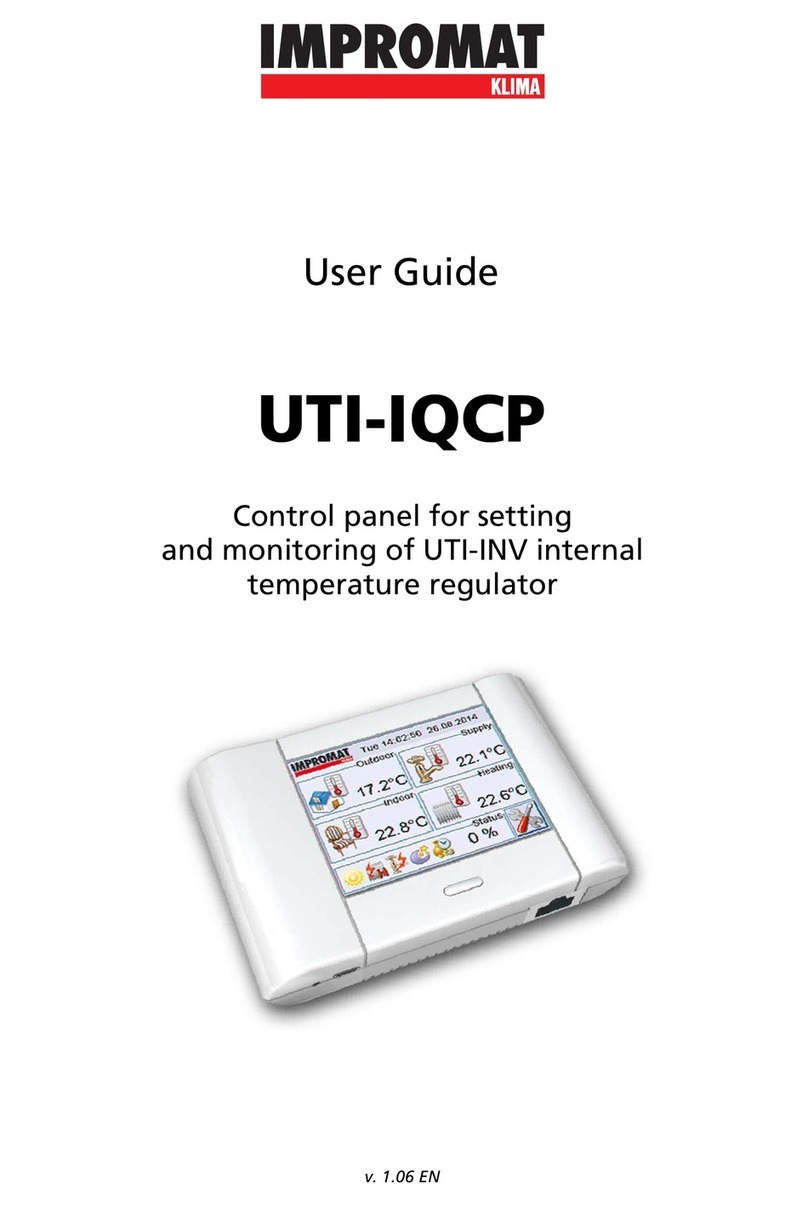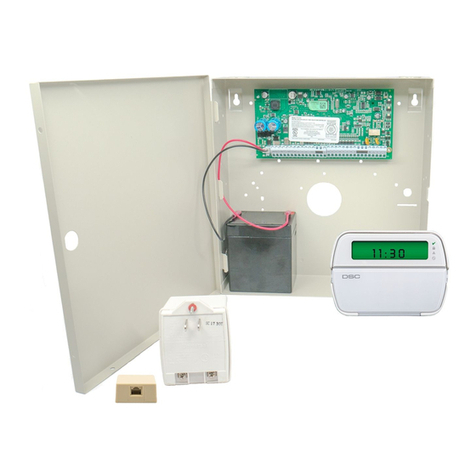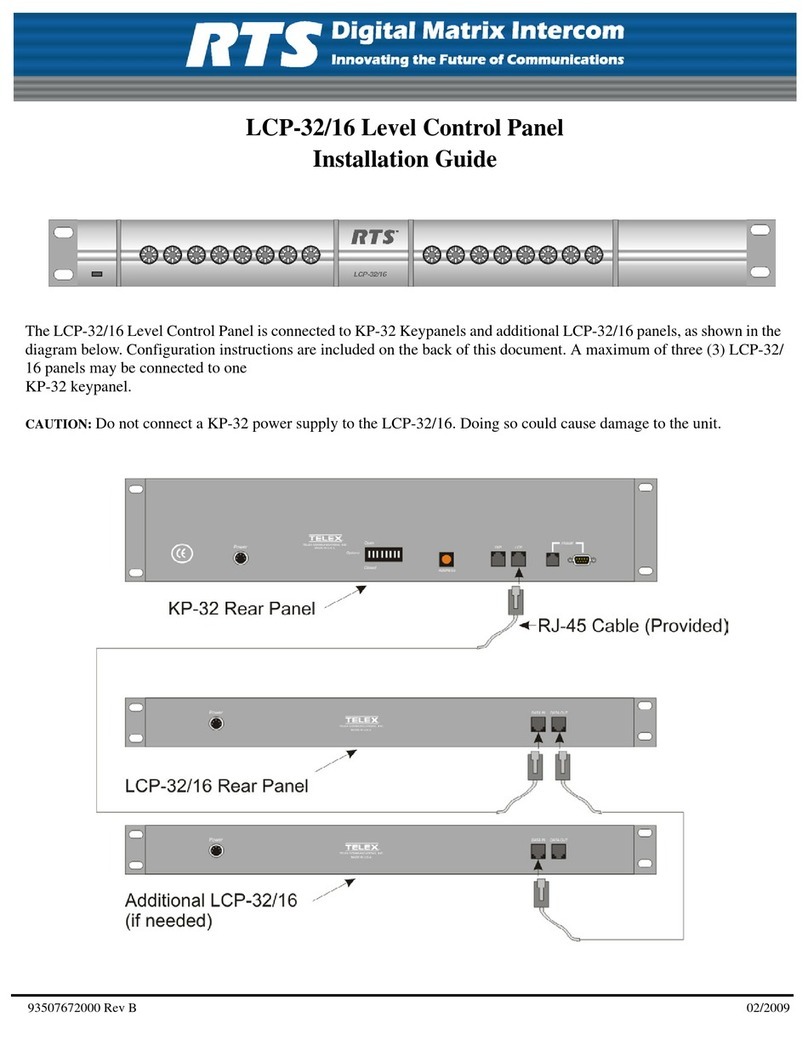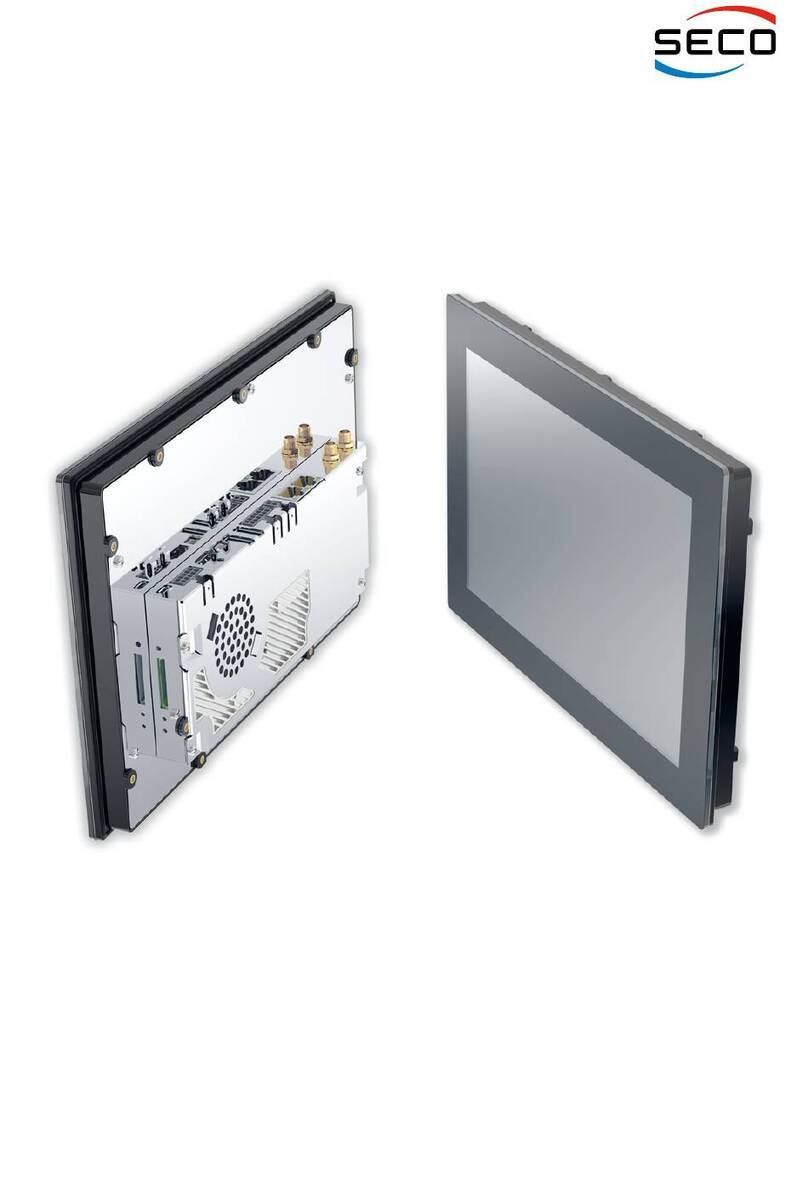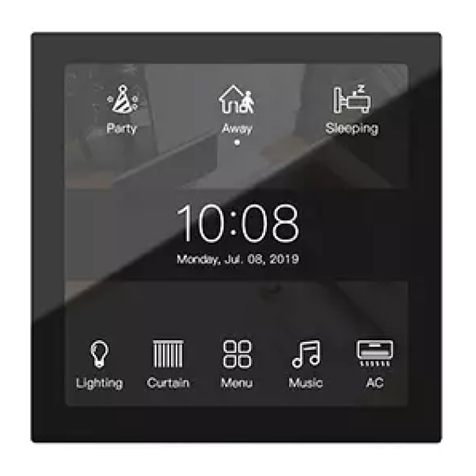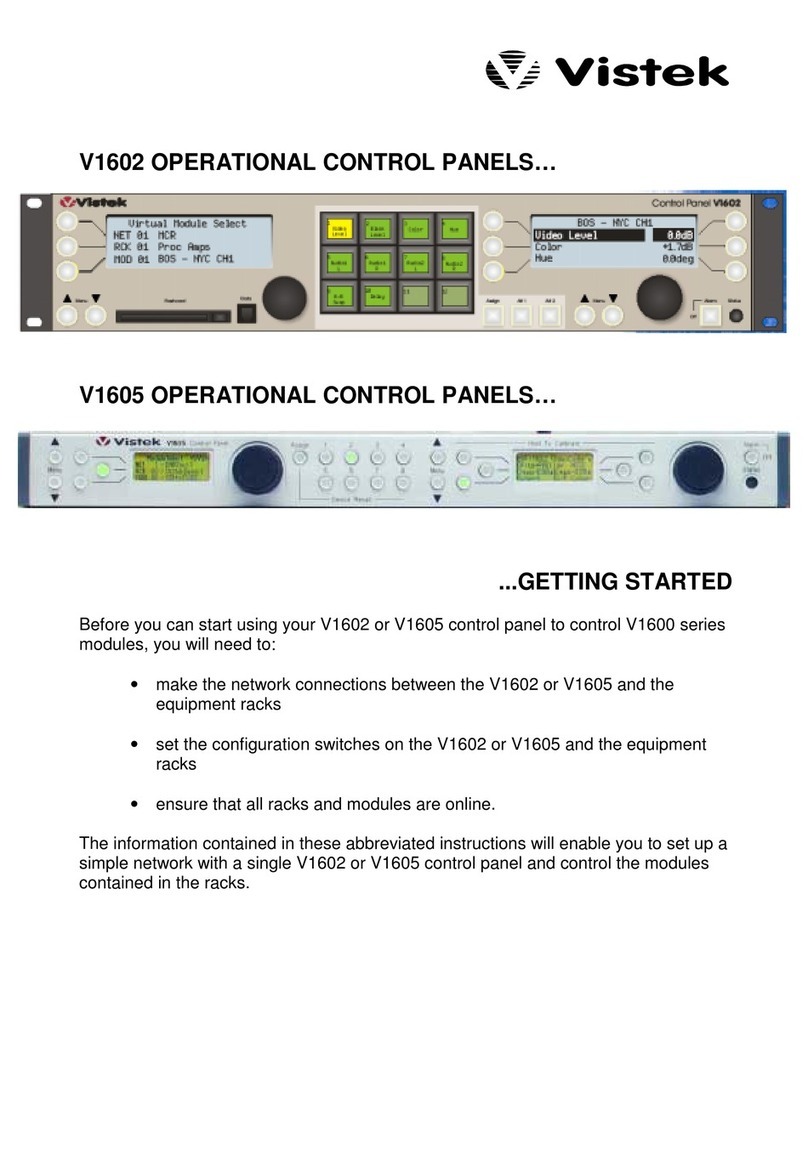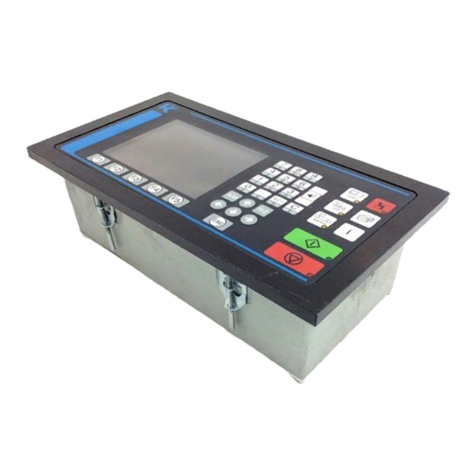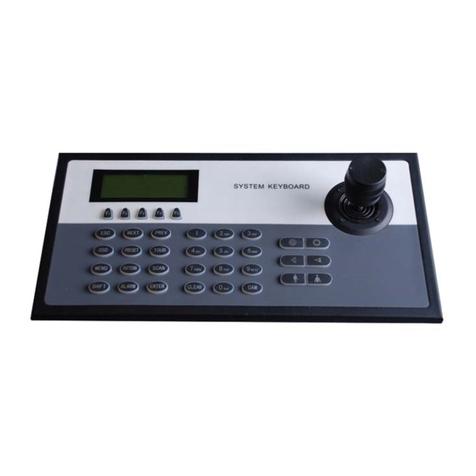tau K205M User manual

1
K205M
GUIDA ALL’INSTALLAZIONE
INSTALLATION GUIDE
INSTALLATIONSANLEITUNG
NOTICE D’INSTALLATION
GUÍA PARA LA INSTALACIÓN
GUIA DE INSTALAÇÃO
K205M
Quadro di comando per barriere automatiche
Control panel for automatic barriers
Steuerplatine für den Automatischen Schranken
Logique de commande pour barrières automatiques
Panel de mandos para barreras automáticas
Quadro de comando para barreiras automáticas
Via Enrico Fermi, 43 - 36066 Sandrigo (VI) Italia
Tel +39 0444 750190 - Fax +39 0444 750376
info@tauitalia.com - www.tauitalia.com
IT - Istruzioni originali
D-MNL0K205M 19-09-2014 - Rev.19

2
K205M
+ ~
-~ + +
+
-+-+-
+
TCA RALL
FR
+
1
2
3
4
5
6
7
8
15 14 13 12 11 10 9
16
20
17
18
19
21
22
23
24
CHARGE BATT.
Photocells
Close
Photocell
Common
Bar Led Flashing
light
18 Vdc
max. 20W
Open/Close
Stop
Common
Open
Antenna
2nd radio
channel
M
+5V
ENC
GND
123 4 5 6
7 8
RX
AP
DL1
DL2
DL4
DL3
DL5
DL6
A/C STOP FOT CH
876
5
43
2
1
OFF
ON Dip-switches
K205M
P1
PROG
FS1
FS2
F2 5x20 F10A
F3 5x20 F1,6A
F1 5x20 F16A
RADIO CONNECTOR
+
-
+
-
+
-
+
-
+
-
TX = Transmitter
RX = Receiver
M = Motor
RX
12345
TX
1 2
SCHEMA CABLAGGIO K205M / K205M WIRING DIAGRAM / SCHALTPLAN DER K205M
+ ~
-~ + + +
-+-+-+
TCA RALL FR
+
1
2
3
4
5
6
7
8
15 14 13 12 11 10 9
16
20
17
18
19
21
22
23
24
CHARGE BATT.
Photocells
Close
Photocell
Common
Bar Led Flashing
light
18 Vdc
max. 20W
Open/Close
Stop
Common
Open
Antenna
2nd radio
channel
M
+5V
ENC
GND
123 4 5 6 7 8
RX
AP
DL1
DL2
DL4
DL3
DL5
DL6
A/C STOP FOT CH
876
5
43
2
1
OFF
ON Dip-switches
K205M
P1
PROG
FS1
FS2
F2 5x20 F10A
F3 5x20 F1,6A
F1 5x20 F16A
RADIO CONNECTOR
+
-
+
-
+
-
+
-
+
-
TX = Transmitter
RX = Receiver
M = Motor
RX
12345
TX
1 2

3
K205M
+ ~
-~ + +
+
-+-+-
+
TCA RALL
FR
+
1
2
3
4
5
6
7
8
15 14 13 12 11 10 9
16
20
17
18
19
21
22
23
24
CHARGE BATT.
Photocells
Close
Photocell
Common
Bar Led Flashing
light
18 Vdc
max. 20W
Open/Close
Stop
Common
Open
Antenna
2nd radio
channel
M
+5V
ENC
GND
123 4 5 6 7
8
RX
AP
DL1
DL2
DL4
DL3
DL5
DL6
A/C STOP FOT CH
876
5
43
2
1
OFF
ON Dip-switches
K205M
P1
PROG
FS1
FS2
F2 5x20 F10A
F3 5x20 F1,6A
F1 5x20 F16A
RADIO CONNECTOR
+
-
+
-
+
-
+
-
+
-
TX = Transmitter
RX = Receiver
M = Motor
RX
12345
TX
1 2
SCHÉMA CÂBLAGE K205M / ESQUEMA DEL CABLEADO K205M / ESQUEMA ELÉCTRICO K205M
+ ~
-~ + + +
-+-+-+
TCA RALL FR
+
1
2
3
4
5
6
7
8
15 14 13 12 11 10 9
16
20
17
18
19
21
22
23
24
CHARGE BATT.
Photocells
Close
Photocell
Common
Bar Led Flashing
light
18 Vdc
max. 20W
Open/Close
Stop
Common
Open
Antenna
2nd radio
channel
M
+5V
ENC
GND
123 4 5 6 7 8
RX
AP
DL1
DL2
DL4
DL3
DL5
DL6
A/C STOP FOT CH
876
5
43
2
1
OFF
ON Dip-switches
K205M
P1
PROG
FS1
FS2
F2 5x20 F10A
F3 5x20 F1,6A
F1 5x20 F16A
RADIO CONNECTOR
+
-
+
-
+
-
+
-
+
-
TX = Transmitter
RX = Receiver
M = Motor
RX
12345
TX
1 2

4
K205M
SCHEDA CARICA BATTERIA (OPZIONALE)
BATTERY CHARGER BOARD (OPTIONAL)
BATTERIELADEKARTE (OPTIONAL)
CARTE CHARGEUR DE BATTERIE (EN OPTION)
TARJETA CARGA BATERÍA (OPCIONAL)
PLACA DE CARGA BATERIA (OPCIONAL)
F 8A - 5x20 Fusibile rapido 10 Ah 5x20 a protezione della batteria 12 V 7,2 Ah
DL1 led verde di segnalazione presenza di tensione di rete.
F 8A - 5x20 10 Ah 5x20 fast-acting fuse for protection of 12 V 7.2 Ah battery
DL1 Presence power supply green LED signal.
F 8A - 5x20 Schnellsicherung 10 Ah 5x20 zum Schutz der Batterie 12 V 7,2 Ah
DL1 grüne LED für Stromverorgungs Kontrolle.
F 8A - 5x20 Fusible rapide 10 Ah 5x20 pour la protection de la batterie 12 V 7,2 Ah
DL1 led verte de signalisation présence de courant.
F 8A - 5x20 Fusible rápido 10 Ah 5x20 como protección de la batería 12 V 7,2 Ah
DL1 led verde de aviso presencia de alimentación.
F 8A - 5x20 Fusível rápido 10Ah 5x20 de protecção da bateria 12V 7,2 Ah
DL1 LED verde que indica a presença de tensão de rede.

5
K205M
ITALIANO
DICHIARAZIONE DI INCORPORAZIONE DEL COSTRUTTORE
(ai sensi della Direttiva Europea 2006/42/CE AlI. II.B)
Fabbricante: TAU S.r.l.
Indirizzo: Via E. Fermi, 43
36066 Sandrigo (Vi)
ITALIA
Dichiara sotto la propria responsabilità che il prodotto: Centrale di comando
realizzato per il movimento automatico di: Barriere stradali
per uso in ambiente: Generico
completo di: -
Modello: K205M
Tipo: K205M
Numero di serie: vedi etichetta argentata
Denominazione commerciale: Quadro di comando per barriere automatiche
È realizzato per essere incorporato su una chiusura (barriera automatica) o per essere assemblato con altri dispositivi
al ne di movimentare una tale chiusura per costituire una macchine ai sensi della Direttiva Macchine 2006/42/CE.
Dichiara inoltre che questo prodotto è conforme ai requisiti essenziali di sicurezza delle seguenti ulteriori direttive
CEE:
- 2006/95/CE Direttiva Bassa Tensione
- 2004/108/CE Direttiva Compatibilità Elettromagnetica
ed, ove richiesto, alla Direttiva:
- 1999/5/CE Apparecchiature Radio e apparecchiature terminali di telecomunicazione
Dichiara inoltre che non è consentito mettere in servizio il macchinario no a che la macchina in cui sarà
incorporato o di cui diverrà componente sia stata identicata e ne sia stata dichiarata la conformità alle condizioni
della Direttiva 2006/42/CE.
Si impegna a trasmettere, su richiesta adeguatamente motivata delle autorità nazionali, informazioni pertinenti sulle
quasi-macchine.
Sandrigo, 31/03/2010
Il Rappresentante Legale
_________________________________________
Bruno Danieli
Nome e indirizzo della persona autorizzata a costituire la documentazione tecnica pertinente:
Loris Virgilio Danieli - via E. Fermi, 43 - 36066 Sandrigo (Vi) Italia

6
K205M
AVVERTENZE
Il presente manuale è destinato solamente al personale tecnico qualicato per l’installazione.
Nessuna informazione contenuta nel presente fascicolo può essere considerata d’interesse per
l’utilizzatore nale. Questo manuale è allegato alla centralina K205M montata sulla barriera
RBLO, RBL4, CITY/M e CITY/O; non deve pertanto essere utilizzato per prodotti diversi!
Avvertenze importanti:
Togliere l’alimentazione di rete alla scheda prima di accedervi.
La centralina K205M è destinata al comando di un motoriduttore elettromeccanico in corrente
continua per l’automazione di barriere automatiche.
Ogni altro uso è improprio e, quindi, vietato dalle normative vigenti.
È nostro dovere ricordare che l’automazione che state per eseguire, è classicata come “co-
struzione di una macchina” e quindi ricade nel campo di applicazione della direttiva europea
2006/42/CE (Direttiva Macchine).
Questa, nei punti essenziali, prevede che:
- l’installazione deve essere eseguita solo da personale qualicato ed esperto;
- chi esegue l’installazione dovrà preventivamente eseguire “l’analisi dei rischi” della macchi-
na;
- l’installazione dovrà essere fatta a “regola d’arte”, applicando cioè le norme;
- inne dovrà essere rilasciata al proprietario della macchina la”dichiarazione di conformità”.
Risulta chiaro quindi che l’installazione ed eventuali interventi di manutenzione devono essere
effettuati solo da personale professionalmente qualicato, in conformità a quanto previsto dalle
leggi, norme o direttive vigenti.
Nella progettazione delle proprie apparecchiture, TAU rispetta le normative applicabili al prodot-
to (vedere la dichiarazione di conformità allegata); è fondamentale che anche l’installatore, nel
realizzare gli impianti, prosegua nel rispetto scrupoloso delle norme.
Personale non qualicato o non a conoscenza delle normative applicabili alla categoria dei “can-
celli e porte automatiche” deve assolutamente astenersi dall’eseguire installazioni ed impianti.
Chi non rispetta le normative è responsabile dei danni che l’impianto potrà causare!
Si consiglia di leggere attentamente tutte le istruzioni prima di procedere con l’installazione.
INSTALLAZIONE
Prima di procedere assicurarsi del buon funzionamento della parte meccanica. Vericare
inoltre che il gruppo motoriduttore sia stato installato correttamente seguendo le
relative istruzioni. Eseguiti questi controlli, assicurarsi che il motoriduttore non abbia un
assorbimento durante il movimento superiore a 3 A (per un corretto funzionamento del
quadro di comando).
L’INSTALLAZIONE DELL’APPARECCHIATURA DEVE ESSERE EFFETTUATA “A REGOLA
D’ARTE” DA PERSONALE QUALIFICATO COME DISPOSTO DALLA LEGGE 37/08.
NB: si ricorda l’obbligo di mettere a massa l’impianto nonché di rispettare le normative
sulla sicurezza in vigore in ciascun paese.
LA NON OSSERVANZA DELLE SOPRAELENCATE ISTRUZIONI PUÒ PREGIUDICARE
IL BUON FUNZIONAMENTO DELL’APPARECCHIATURA E CREARE PERICOLO PER LE
PERSONE, PERTANTO LA “CASA COSTRUTTRICE” DECLINA OGNI RESPONSABILITÀ
PER EVENTUALI MAL FUNZIONAMENTI E DANNI DOVUTI ALLA LORO INOSSERVANZA.
ITALIANO

7
K205M
QUADRO DI COMANDO PER BARRIERE AUTOMATICHE
• LOGICA CON MICROPROCESSORE
• STATO DEGLI INGRESSI VISUALIZZATO DA LEDs
• FUNZIONE “INGRESSO PEDONALE”
• CIRCUITO DI LAMPEGGIO INCORPORATO
•
SENSORE AD ENCODER PER RILEVAMENTO OSTACOLI ED AUTOAPPRENDIMENTO DELLA
CORSA
• CONNETTORE PER RICEVENTE
• CONNETTORE PER BATTERIA E CARICA BATTERIA (OPZIONALE)
• DIAGNOSTICA DEL DIFETTO FUNZIONE VISUALIZZATO DA LED
ATTENZIONE:
- non utilizzare cavi unilari (a conduttore unico), es. quelli citofonici, al ne di evitare
interruzioni sulla linea e falsi contatti;
- non riutilizzare vecchi cavi preesistenti;
- si consiglia di utilizzare il cavo TAU cod. M-03000010CO per il collegamento dei motori
alla centrale di comando.
COLLAUDO
A collegamento ultimato:
• I Leds verdi LS devono essere tutti accesi (corrispondono ciascuno ad un ingresso Normal-
mente Chiuso). Si spengono solo quando sono interessati i comandi ai quali sono associati.
• I Leds rossi LS devono essere tutti spenti (corrispondono ciascuno ad un ingresso Normal-
mente Aperto) si accendono solo quando sono interessati i comandi ai quali sono associati.
CARATTERISTICHE TECNICHE
Alimentazione scheda 13,5 V AC - 50 Hz
Potenza max. motore c.c. 50 W - 18 V DC
Fusibile rapido protezione alimentazione ingresso 13,5 V AC (F1 - 5x20) F 16A
Fusibile rapido protezione motore (F2 - 5x20) F 10A
Fusibile rapido protezione ausiliari 18 V DC (F3 - 5x20) F 1,6A
Tensione circuiti alimentazione motore 18 V DC
Tensione alimentazione circuiti dispositivi ausiliari 18 V DC
Tensioni alimentazioni circuiti logici 5 V DC
Temperatura di funzionamento -20 °C ÷ +55 °C
COLLEGAMENTI ALLA MORSETTIERA
Morsetti Funzione Descrizione
1 - 2 AUX uscita ausiliari 18 V DC max. 15 W per fotocellule, relay, rice-
vitori, etc... (1 = NEGATIVO - 2 = POSITIVO)
3 - 4 TX FOTOCELLULE uscita 18 V DC fotocellula trasmittente -fototest- max. nr. 1
trasmettitore fotocellule. (3 = NEGATIVO - 4 = POSITIVO)
5 - 6 LAMPEGGIANTE
uscita 18 V DC max. 20W alimentazione lampeggiante,
lampeggio fornito dalla centrale, veloce in chiusura e lento
in apertura.
(5 = NEGATIVO - 6 = POSITIVO)
ITALIANO

8
K205M
7 - 8 LED ASTA uscita 18 V DC alimentazione led asta.
(7 = NEGATIVO - 8 = POSITIVO)
9 - 11 CHIUDE ingresso N.A. pulsante CIHUDE - Comanda la chiusura totale
dell’asta. (9 = CH - 11 = COM)
10 - 11 FOTOCELLULE
ingresso N.C. fotocellule - interviene durante la chiusura o
anche durante l’apertura, vedi dip-switch nr. 3.
(10 = FOT - 11 = COM)
N.B. Il trasmettittore della fotocellula deve sempre essere
alimentato dai morsetti nr 3 e nr 4, in quanto su di esso
si effettua la verica del sistema di sicurezza (Fototest).
Senza questo collegamento, la centralina non funziona.
Per eliminare la verica del sistema di sicurezza, o quando
non si usano le fotocellule, porre il dip-switch nr 6 in OFF.
12 - 13 STOP
ingresso N.C. pulsante STOP - Arresta l’asta dovunque si
trovi, inibendo temporaneamente la chiusura automatica, se
programmata. (12 = COM - 13 = STOP)
12 - 14 APRE/CHIUDE
ingresso N.A. pulsante APRE/CHIUDE - Comanda l’apertura
e la chiusura dell’asta ed è regolato nel funzionamento dai
dip-switches 2 e 4. ( 12 = COM - 14 = A/C)
12 - 15 APRE ingresso N.A. pulsante APRE - Comanda l’apertura totale
dell’asta. (12 = COM - 15 = AP)
16 - 17 ANTENNA ingresso antenna radioricevente ad innesto solo per ricevitori
40,665 MHz. (16 = SEGNALE - 17 = MASSA)
18 - 19 2° CH RADIO
uscita 2° canale radio - per comandare un’altra automazione
o accendere luci, etc... (contatto pulito N.A.)
Nota: per il collegamento di altri dispositivi al 2° canale
radio, quali accensione luci, comando pompe o carichi
importanti, utilizzare un relè ausiliario di potenza con
portata adeguata ai dispositivi da collegare, altrimenti
si potrebbero avere malfunzionamenti dovuti a disturbi
indotti (vedi nota alla ne del paragrafo).
20 - 21 - 22 ENCODER alimentazione e ingresso encoder. (20 = MARRONE positivo
- 21 = BIANCO segnale - 22 = BLU negativo)
23 - 24 MOTORE uscita alimentazione motore 18 V DC max. 50 W.
(23 = POSITIVO - 24 = NEGATIVO)
FS1 - FS2 ALIMENTAZIONE
ingresso alimentazione scheda 13,5 V AC - Alimentato dal
trasformatore toroidale e protetto da fusibile sull’alimentazione
230 V AC.
IMPORTANTE:
•non collegare relè ausiliari o altri dispositivi all’uscita 18V DC (morsetti 1 - 2) della
centrale, onde evitare di pregiudicarne il buon funzionamento. Utilizzare in alternativa
alimentatori/trasformatori esterni;
•non collegare in prossimità della barriera degli alimentatori switching o apparecchiature
similari che potrebbero essere fonte di disturbi;
PROCEDURA DI MEMORIZZAZIONE
ATTENZIONE: dopo aver alimentato il quadro di comando attendere 2 sec. prima di iniziare
a svolgere le manovre di regolazione.
ITALIANO

9
K205M
NOTA: i necorsa meccanici dell’asta devono necessariamente essere regolati sia in
apertura che in chiusura [vedi istruzioni RBL e CITY].
Terminata l’installazione dell’automazione:
1_ portare l’asta a 45° ca.;
2_ posizionare il dip-switch nr. 8 in ON;
3_ comandare l’automazione agendo su uno dei seguenti ingressi: A/C, radiocomando o pulsante
scheda.
4_ l’asta deve cominciare a chiudere.
NOTA: nel caso dovesse aprirsi, sospendere la programmazione resettando il quadro
elettrico (togliere l’alimentazione al quadro per almeno 5 sec. e rimettere il dip-switch nr.
8 in OFF), e quindi a quadro disalimentato invertire tra di loro i li di alimentazione del
motore. Riprendere poi la procedura dal punto 1.
5_ effettuata la chiusura, trascorso un tempo di circa 2 sec., viene eseguita automaticamente
un’apertura totale;
6_ ad apertura completata, posizionare il dip-switch nr. 8 in OFF;
7_ l’automazione è ora pronta per il funzionamento.
Effettuare le regolazioni logiche.
NOTA: agendo su qualsiasi regolazione del quadro di comando (trimmer o dip-switches)
è necessario effettuare una manovra completa (apertura e chiusura) dell’automazione per
rendere attive le nuove impostazioni.
REGOLAZIONI LOGICHE
TRIMMER
RALL. regolazione distanza di rallentamento: da 10 a 100 cm ca.;
T.C.A. regolazione Tempo di Chiusura Automatica: da 0 a 25 secondi ca. (vedi
dip-switch nr. 1);
FR. regolazione sensibilità rilevamento ostacoli.
NOTA: ruotando il TRIMMER FR. in senso orario si diminuisce la sensibilità
del motoriduttore sull’ostacolo e quindi aumenta la forza di spinta; viceversa,
ruotandolo in senso antiorario, aumenta la sensibilità del motoriduttore
sull’ostacolo e diminuisce la forza di spinta.
TCA RALL FR
- + - + - +
Dip switch
1CHIUSURA
AUTOMATICA
On ad apertura completata, la chiusura dell’asta è automatica trascorso
un tempo impostato sul trimmer T.C.A.;
Off la chiusura necessita di un comando manuale;
22 / 4 TEMPI
On
ad automazione funzionante, una sequenza di comandi di apertura/
chiusura induce l’asta ad una APERTURA-CHIUSURA-APERTURA-
CHIUSURA, etc.
Off
nelle stesse condizioni, la stessa sequenza di comandi induce l’asta
ad una APERTURA-STOP-CHIUSURA-STOP-APERTURA-STOP,
etc. (funzione passo-passo) (vedi anche dip switch 4);
3SETTAGGIO
RALLENTAM.
On settaggio rallentamento per barriera CITY/M e CITY/O;
Off settaggio rallentamento per barriera CITY/V, RBL4 e RBLO;
4NO REVERSE On l’asta si comporta come stabilito dal dip switch nr. 2
Off l’asta ignora i comandi di chiusura durante l’apertura;
5PRE-
LAMPEGGIO
On la funzione prelampeggio è inserita;
Off la funzione prelampeggio è disinserita;
ITALIANO

10
K205M
6FOTOTEST
On la funzione “verica delle fotocellule” è inserita;
Off la funzione “verica delle fotocellule” è disinserita. Nota: da utilizzare
quando non si usano le fotocellule;
7SETTAGGIO
BARRIERA
On impostare per CITY/V, RBL4 e RBLO;
Off impostare per CITY/M e CITY/O;
8MEMO
On si abilita la funzione di memorizzazione per l’autoapprendimento
della corsa;
Off posizione in cui lasciare il dip-switch al termine della procedura di
memorizzazione.
APERTURA E CHIUSURA COMANDATA DA OROLOGIO
É possibile comandare l’apertura e la chiusura dell’automazione mediante un orologio digitale
che in uscita disponga di un contatto pulito N.A. (relè).
Sarà sufciente collegarlo ai morsetti 12 - 14 (pulsante APRE/CHIUDE) e programmarlo in modo
che, all’ora di apertura desiderata, il contatto relè dell’orologio si chiuda sino all’ora di chiusura
voluta (momento in cui il contatto relè dell’orologio si apre nuovamente, permettendo così la
richiusura automatica).
Nota: la richiusura automatica deve essere inserita (Dip-switch nr. 1 in ON).
CARATTERISTICHE DELLA K205M
LED - DL3
Il led, oltre ad indicare la presenza dell’alimentazione, segnala eventuali errori con una serie di
lampeggi predeniti:
sempre acceso: funzionamento regolare;
1 lampeggio: tensione della batteria tampone inferiore a 11,3 Vdc;
Controllare l’alimentazione di rete, caricare la batteria, sostituire la batteria;
2 lampeggi: errore fototest;
Disabilitare fototest (dip-switch 6 in OFF), vericare funzionamento fotocellule e loro collega-
mento;
3 lampeggi: mancanza tensione di rete;
Controllare interruttore magnetotermico (a monte dell’impianto), controllare fusibili;
4 lampeggi: superamento limite max. di corrente;
Picco di eccessivo assorbimento del motoriduttore, controllare l’assenza di ostacoli lungo la
corsa dell’asta, vericare l’assorbimento di corrente del motore a vuoto e applicato all’asta;
5 lampeggi: assenza segnale encoder / assenza segnale motore;
Controllare cablaggio, vericare encoder tramite TEST-ENCODER (opzionale);
Controllare cablaggio, vericare che il motore giri liberamente alimentato direttamente dalla
batteria, vericare fusibile F2;
6 lampeggi: presenza ostacolo dopo 5 tentativi di chiusura falliti;
Controllare l’assenza di ostacoli lungo la corsa dell’asta e il bilanciamento della stessa;
7 lampeggi: non è stata eseguita alcuna procedura di memorizzazione;
Eseguire procedura di memorizzazione.
L’indicazione di più errori viene eseguita con una pausa di 2 sec. tra una segnalazione e l’altra.
Nel caso di 5 interventi consecutivi (durante la stessa manovra di chiusura) da parte dell’enco-
der (rilevazione ostacolo), la centrale apre completamente. Al successivo impulso di comando,
entrerà in fase di corsa rallentata alla ricerca della battuta in chiusura.
ITALIANO

11
K205M
ELETTROMAGNETE (18 V DC - max. 3W)
Uscita per elettromagnete da collegare in testa all’asta per la tenuta in chiusura (antivandali-
smo).
A sbarra chiusa l’elettromagnete viene costantemente alimentato. Ad ogni comando, prima della
marcia del motore (2 sec. ca.) viene disattivato l’elettromagnete.
SCHEDA CARICA BATTERIA (OPZIONALE)
Se si possiede la scheda carica batteria, in assenza di rete l’automazione risulta comunque
funzionante. Nel caso la tensione scenda sotto gli 11,3 V DC, l’automazione cessa di funzionare
(il quadro di comando rimane alimentato); quando, invece, scende sotto i 10,2 V DC, la scheda
sgancia completamente la batteria (il quadro di comando non è più alimentato).
RILEVAMENTO OSTACOLI
La funzione di rilevamento ostacoli (impostabile tramite trimmer FR) intervenendo in fase di
apertura dell’automazione provoca una richiusura della stessa di 20 cm ca., mentre in fase di
chiusura provoca un’apertura totale.
ATTENZIONE: la logica del quadro di comando può interpretare un attrito meccanico per
un eventuale ostacolo.
RALLENTAMENTO
Per evitare che l’asta sbatta alla ne della corsa, è possibile impostare (tramite il trimmer RALL)
il rallentamento in apertura e in chiusura su una distanza variabile da 10 a 100 cm. (ruotando il
trimmer in senso orario si aumenta la distanza di rallentamento; viceversa, ruotandolo in senso
antiorario la distanza di rallentamento si accorcia). Per i mod. CITY/V, RBL4 e RBLO impostare
il RALL al max.
Nota: il pulsante P1 della scheda ha la stessa funzione del tasto APRE/CHIUDE.
LED DI DIAGNOSI
DL1 led rosso di segnalazione pulsante APRE
DL2 led rosso di segnalazione pulsante APRE/CHIUDE
DL3 led rosso di segnalazione ERRORI
DL4 led verde di segnalazione pulsante di STOP
DL5 led verde di segnalazione FOTOCELLULA
DL6 led rosso di segnalazione pulsante CHIUDE
MALFUNZIONAMENTI: POSSIBILI CAUSE E RIMEDI
L’automazione non parte
a- Vericare con lo strumento (Multimetro) la presenza dell’alimentazione 230V AC;
b- Vericare che i contatti N.C. della scheda siano effettivamente normalmente chiusi (2 led
verdi accesi);
c- Impostare il dip 6 (fototest) su OFF;
d- Aumentare il trimmer FR al massimo;
e- Controllare con lo strumento (Multimetro) che i fusibili siano integri.
Il radiocomando ha poca portata
a- Collegare l’antenna radio sui morsetti presenti sulla scheda ricevente e non sui morsetti
16-17 della scheda di comando (per frequenza 433,92 MHz);
b- Controllare che il collegamento della massa e del segnale dell’antenna non sia invertito;
c- Non eseguire giunzioni per allungare il cavo dell’antenna;
d- Non installare l’antenna in posizioni basse o in posizioni nascoste dalla muratura o dal
pilastro;
e- Controllare lo stato delle pile del radiocomando.
L’automazione si apre al contrario
Invertire tra loro i collegamenti del motore sulla morsettiera (morsetti 23 e 24);
ITALIANO

12
K205M
MANUFACTURER’S DECLARATION OF INCORPORATION
(in accordance with European Directive 2006/42/EC App. II.B)
Manufacturer: TAU S.r.l.
Address: Via E. Fermi, 43
36066 Sandrigo (Vi)
ITALY
Declares under its sole responsibility, that the product: Electronic control unit
designed for automatic movement of: Road barriers
for use in a: General environment
complete with: -
Model: K205M
Type: K205M
Serial number: see silver label
Commercial name: Control panel for automatic barriers
Has been produced for incorporation on an access point (automatic barrier) of for assembly with other devices used
to move such an access point, to constitute a machine in accordance with the Machinery Directive 2006/42/EC.
Also declares that this product complies with the essential safety requirements of the following EEC directives:
- 2006/95/EC Low Voltage Directive
- 2004/108/EC Electromagnetic Compatibility Directive
and, where required, with the Directive:
- 1999/5/CE Radio equipment and telecommunications terminal equipment
Also declares that it is not permitted to start up the machine until the machine in which it is incorporated or of
which it will be a component has been identied with the relative declaration of conformity with the provisions of
Directive 2006/42/EC.
The manufacturer undertakes to provide, on sufciently motivated request by national authorities, all information
pertinent to the quasi-machinery.
Sandrigo, 31/03/2010
Legal Representative
_________________________________________
Bruno Danieli
Name and address of person authorised to draw up all pertinent technical documentation:
Loris Virgilio Danieli - via E. Fermi, 43 - 36066 Sandrigo (Vi) Italy
ENGLISH

13
K205M
ENGLISH
WARNINGS
This manual is designed to assist qualied installation personnel only. It contains no information
that may be of interest to nal users. This manual is attached to the K205M control unit mounted
on the RBL4, RBLO, CITY/M and CITY/O automatic bar, therefore it may not be used for differ-
ent products!
Important warnings:
Disconnect the mains power supply to the board before accessing it.
The K205M control unit is suitable for the control of a direct-current electromechanical gearmo-
tor for the automation of sliding gates.
Any other use is considered improper and is consequently forbidden by current laws.
Please note that the automation system you are going to install is classi ed as “machine con-
struction” and therefore is included in the application of European directive 2006/42/EC (Ma-
chinery Directive).
This directive includes the following prescriptions:
- Only trained and qualied personnel should install the equipment;
- the installer must rst make a “risk analysis” of the machine;
- the equipment must be installed in a correct and workmanlike manner in compliance with all
the standards concerned;
- after installation, the machine owner must be given the “declaration of conformity”.
This product may only be installed and serviced by qualied personnel in compliance with cur-
rent, laws, regulations and directives.
When designing its products, TAU observes all applicable standards (please see the attached
declaration of conformity) but it is of paramount importance that installers strictly observe the
same standards when installing the system.
Unqualied personnel or those who are unaware of the standards applicable to the “automatic
gates and doors” category may not install systems under any circumstances.
Whoever ignores such standards shall be held responsible for any damage caused by
the system!
Do not install the unit before you have read all the instructions.
INSTALLATION
Before proceeding, make sure the mechanical components work correctly. Also check
that the gear motor assembly has been installed according to the instructions. Then
make sure that the power consumption of the gear motor is not greater than 3A (other-
wise the control panel may not work properly).
THE EQUIPMENT MUST BE INSTALLED “EXPERTLY” BY QUALIFIED PERSONNEL AS RE-
QUIRED BY LAW.
Note: it is compulsory to earth the system and to observe the safety regulations that are
in force in each country.
IF THESE ABOVE INSTRUCTIONS ARE NOT FOLLOWED IT COULD PREJUDICE THE
PROPER WORKING ORDER OF THE EQUIPMENT AND CREATE HAZARDOUS SITUA-
TIONS FOR PEOPLE. FOR THIS REASON THE “MANUFACTURER” DECLINES ALL RE-
SPONSIBILITY FOR ANY MALFUNCTIONING AND DAMAGES THUS RESULTING.

14
K205M
CONTROL PANEL FOR AUTOMATIC BARS
• LOGICS WITH MICROPROCESSOR
• STATUS OF INPUTS SIGNALLED BY LEDs
• “PEDESTRIAN GATE” FUNCTION
• INCORPORATED FLASHING CIRCUIT
• ENCODER SENSOR FOR OBSTACLE DETECTION AND SELF-LEARNING OF TRAVEL
• RECEIVER CONNECTOR
• BATTERY AND BATTERY CHARGER CONNECTOR (OPTIONAL)
• DIAGNOSTICS OF MALFUNCTIONS SIGNALLED BY LED
ATTENTION:
- do not use single cables (with one single wire), ex. telephone cables, in order to avoid
breakdowns of the line and false contacts;
- do not re-use old pre-existing cables;
- we recommend to use the TAU cable code M-03000010C0 to connect the motors to the
control board.
TESTING
When you have completed the connection:
• All the green LS LEDs must be on (each of them corresponds to a Normally Closed input).
The go off only when the controls to which they are associated are operated.
• All the red LS LEDs must be off (each of them corresponds to a Normally Open input). The
light up only when the controls to which they are associated are operated.
TECHNICAL CHARACTERISTICS
Board power supply 13,5 V AC - 50 Hz
Max motor power DC 50 W - 18 V DC
Fast acting fuse for protection of input power supply 13,5 V AC (F1 - 5x20) F 16A
Fast acting fuse for motor protection (F2 - 5x20) F 10A
Fast acting fuse for protection of auxiliary circuits 18 V DC (F3 - 5x20) F 1,6A
Motor power supply circuits voltage 18 V DC
Auxiliary device circuits supply voltage 18 V DC
Logic circuits supply voltages 5 V DC
Operating temperature -20 °C ÷ +55 °C
CONNECTIONS TO TERMINAL BOARD
Terminals Function Description
1 - 2 AUX auxiliary circuits output 18 V DC max. 15 W for photocells,
relays, receivers, etc... (1 = NEGATIVE - 2 = POSITIVE)
3 - 4 TX PHOTOCELLS 18 V DC output for transmitter photocell – phototest - max.
no. 2 photocell transmitters. (3 = NEGATIVE - 4 = POSITIVE)
5 - 6 FLASHING LIGHT
18 V DC max. 20W output for ashing light supply, ashing
signal supplied by the control unit, rapid for closing, slow for
opening. (5 = NEGATIVE - 6 = POSITIVE)
7 - 8 BAR LED max. 18 V DC bar LED power output.
(7 = NEGATIVE - 8 = POSITIVE);
ENGLISH

15
K205M
ENGLISH
9 - 11 CLOSE CLOSE button N.O. input – Controls the total closure of the
bar. (9 = CLOSE - 11 = COM)
10 - 11 PHOTOCELLS
N.C. photocell input - it cuts in during the closing or the open-
ing manoeuvre, see dip-switch no. 3. (10 = FOT - 11 = COM)
Note: the photocell transmitter must always be supplied
by terminals no. 3 and no. 4, since the safety system test
(phototest) is carried out on it. Without this connection,
the control unit does not work. To override the testing of
the safety system, or when the photocells are not used,
set dip-switch no. 6 to OFF.
12 - 13 STOP
STOP button N.C. input – Stops the bar in any position,
temporarily preventing the automatic closure, if programmed.
(12 = COM - 13 = STOP)
12 - 14 OPEN/CLOSE
OPEN/CLOSE button N.O. input – Controls the opening and
closing of the bar and is regulated based on the function of
dip-switches 2 and 4. ( 12 = COM - 14 = O/C)
12 - 15 OPEN OPEN button N.O. input – Controls the total opening of the
bar. (12 = COM - 15 = OPEN)
16 - 17 AERIAL plug-in radio-receiver aerial input , for 40.665 MHz receivers
only. (16 = SIGNAL - 17 = GROUND)
18 - 19 2nd CH RADIO
2nd radio channel output - for control of an additional automa-
tion or for switching on lights, etc... (N.O. clean contact)
Warning: to connect other devices to the 2nd Radio
Channel (area lighting, pumps, etc.), use an additional
auxiliary relay (see note at end of paragraph).
20 - 21 - 22 ENCODER encoder supply and input. (20 = BROWN positive - 21 =
WHITE signal - 22 = BLUE negative);
23 - 24 MOTOR motor supply output 18 V DC max. 50 W.
(23 = POSITIVE - 24 = NEGATIVE)
FS1 - FS2 POWER SUPPLY
13,5 V AC control unit power supply input – Fed by the toroi-
dal transformer and protected by the fuses on the 230 V AC
power supply.
IMPORTANT:
•Do not connect auxiliary relays or other devices tot he 18 V DC output (terminals 1 – 2)
to avoid malfunctions of the control unit. Use separated power supply / transformers
instead;
•do not connect switching feeders or similar apparatus close to the barrier that may be
a source of disturbance;
MEMORIZATION PROCEDURE
WARNING: After powering the control panel, wait 2 seconds before you start performing
the adjustment operations.
Note: the mechanical stops of the bar must be regulated both in opening and in closing
[see RBL and CITY instructions].
When you have completed the installation procedures :
1_ place the bar at approx. 45°;
2_ set dip-switch no. 8 to ON;
3_ control the automation with one of the following inputs: O/C, radio control or control unit but-
ton.

16
K205M
4_ the bar should start to close.
Note: if it opens, stop the programming procedure by resetting the electric panel (discon-
nect the power supply to the panel for at least 5 sec. and set dip-switch no. 8 to OFF); with
the control panel disconnected, exchange the motor supply wires. Restart the procedure
from point 1.
5_ when the gate has closed, after approximately 2 seconds a complete opening manoeuvre is
executed automatically;
6_ when the gate has opened, set dip-switch no. 8 to OFF;
7_ the automation is now ready for operation.
Make the logic adjustments.
Note: when any adjusting devices (trimmers or dip-switches) on the control panel are oper-
ated, a complete manoeuvre must be carried out in order for the new settings to take effect.
LOGIC ADJUSTMENTS
TRIMMER
RALL. slowdown distance adjustment: from about 10 to 100 cm;
T.C.A. Automatic Closing time adjustment: from about 0 to 25 seconds (see dip-
switch no. 1);
FR. obstacle detection sensitivity adjustment.
Note: by rotating the TRIMMER FR. clockwise the sensitivity of the gear-
motor to obstacles diminishes and therefore the thrust force increases; vice-
versa, by rotating it counter-clockwise, the sensitivity of the gearmotor to
obstacles increases and therefore the thrust force diminishes.
TCA RALL FR
- + - + - +
Dip switch
1AUTOMATIC
CLOSING
On when completely open, closure is automatic after the set time on the
T.C.A. trimmer has past;
Off the closing manoeuvre requires a manual command;
22 / 4 STROKE
On when the automation is operating, a sequence of opening/closing
commands causes the bar to OPEN-CLOSE-OPEN-CLOSE, etc.
Off
in the same conditions, the same sequence of commands causes the
bar to OPEN-STOP-CLOSE-STOP-OPEN-STOP, etc . (step-by step
function) (see also dip switch 4);
3SLOW DOWN
SETUP
On slowdown setting for CITY/M and CITY/O barrier;
Off slowdown setting for CITY/V, RBL4 and RBLO barrier;
4NO REVERSE On the bar responds as established by dip switch No. 2
Off the bar ignores the closure command during opening;
5PRE-
FLASHING
On the pre-ashing function is enabled;
Off the pre-ashing function is disabled;
6FOTOTEST
On the “photocell test” function is enabled;
Off the “photocell test” function is disabled. N.B.: to be used when the
photocells are not used;
7BAR
SETUP
On set for CITY/V, RBL4 and RBLO;
Off set for CITY/M and CITY/O;
8MEMO
On the memorization function is enabled for self-learning of the travel;
Off leave the dip-switch in this position when the memorization proce-
dure has been completed.
ENGLISH

17
K205M
ENGLISH
TIMER-OPERATED OPENING AND CLOSING CYCLES
The opening/closing of the automation can be controlled by means of a timer that has a free N.O.
output contact (relay). The timer must be connected to terminals 12 - 14 (OPEN/CLOSE button) and
can be programmed so that, at the desired opening time, the relay contact closes until the desired
closing time (when the timer’s relay contact opens, enabling the automatic closing of the gate).
Note: the automatic closing function must be enabled by setting Dip-switch no. 1 to ON).
K205M CHARACTERISTICS
LED - DL3
The LED, besides indicating that the power supply is connected, also signals errors with a series
of pre-dened ashes:
steady light: normal operation;
1 ash: buffer battery voltage lower than 11,3 V DC;
Check the mains power supply, charge the battery, replace the battery;
2 ashes: phototest error;
Disable phototest (dip-switch 6 OFF), check operation and connection of photocells;
3 ashes: power failure;
Check the thermal-magnetic circuit breaker (upstream from system), check the fuses;
4 ashes: max current limit exceeded;
Excessive absorption peaks of the gearmotor, check that there are no obstacles throughout the
movement of the bar, check the motor’s absorption of current when loadless and applied to the
bar;
5 ashes: absence of encoder signal / no motor signal;
Check wiring, check encoder through TEST-ENCODER (optional);
Check wiring, check that the motor rotates freely when powered directly by battery, check fuse F2;
6 ashes: presence of obstacle after 5 failed attempts to close;
Check that there are no obstacles throughout the movement of the bar and the balance of the
bar;
7 ashes: no memorization procedure has been executed;
Execute memorization procedure.
Multiple errors are signalled by a 2-second pause between signals.
If the encoder is activated 5 consecutive times during the same closing manoeuvre (obstacle
detection), the control unit opens completely. On the next manoeuvre, the control unit will switch
to slow-down mode as it searches for the closing travel limit.
ELECTROMAGNET (18 V DC - max. 3W)
Output for electromagnet to be connected to the end of the rod to hold the barrier closed (van-
dal-resistant device).
With the barrier closed, the electromagnet is constantly powered. Every time a command is
given, the electromagnet is turned off before the motor starts running (approx. 2 sec).
BATTERY CHARGER BOARD (OPTIONAL)
If the system is equipped with a battery charger board, it con operate even during power failures.
If the voltage drops below 11,3 V DC, the automation stops working (the control panel is still
powered). When it drops below 10,2 V DC, the board disconnects the battery completely (the
control panel is no longer powered).

18
K205M
OBSTACLE DETECTION
If the obstacle detection function (which can be set through trimmer FR) is activated during an
opening manoeuvre, the gate closes approx. 20 cm., if it is activated during a closing manoeuvre,
the gate opens all the way .
WARNING: the control panel logics may interpret mechanical friction as an obstacle.
SLOW-DOWN
In order to avoid that the bar slams at the end of its movement, the slowdown of the bar during
opening and closing can be set (by means of the RALL trimmer) at a distance between 10 and
100 cm (rotating the trimmer clockwise the slowdown distance is increased; vice versa, turning
the trimmer anti-clockwise the slowdown distance is shortened). Set the RALL trimmer to its
maximum for CITY/V, RBL4 and RBLO.
Note: the P1 button on the control unit has the same function as the OPEN/CLOSE but-
ton.
DIAGNOSTICS LED
DL1 OPEN button red LED signal
DL2 OPEN/CLOSE button red LED signal
DL3 ERRORS red LED signal
DL4 STOP button green LED signal
DL5 PHOTOCELL green LED signal
DL6 CLOSE button red LED signal
MALFUNCTIONS: POSSIBLE CAUSES AND SOLUTION
The automation does not start
a- Check there is 230V AC power supply with the multimeter;
b- Check that the NC contacts of the card are actually normally closed (3 green LEDs on);
c- Set dip 6 (phototest) to OFF;
d- Increase the FR trimmer to the limit;
e- Check that the fuses are intact with the multimeter.
The radio control has very little range
a- Connect the radio aerial to the terminals of the receiver card and not to terminals 16-17
of the control card (for frequency 433,92 MHz);
b- Check that the ground and the aerial signal connections have not been inverted;
c- Do not make joints to increase the length of the aerial wire;
d- Do not install the aerial in a low position or behind walls or pillars;
e- Check the state of the radio control batteries.
The gate opens the wrong way
Invert the motor connections on the terminal block (terminals 23 and 24)
ENGLISH

19
K205M
INTEGRIERUNGSERKLÄRUNG DES HERSTELLERS
(gemäß der Europäischen Richtlinie 2006/42/EG Anl. II.B)
Hersteller: TAU S.r.l.
Adresse: Via E. Fermi, 43
36066 Sandrigo (Vi)
ITALY
Erklärt unter seiner Haftung, dass das Produkt: Elektronische Steuerung
für die automatische Bewegung von: Schranken
für eine Anwendung: Allgemein
Einschließlich: -
Modell: K205M
Typ: K205M
Seriennummer: siehe Silberetikette
Handelsbezeichnung: Steuerplatine für Automatischen Schranken
ausgeführt wurde, um in einen Verschluss integriert zu werden (Automatic Schranke) oder um mit anderen Vor-
richtungen kombiniert zu werden, um diesen Verschluss zu bewegen, und somit gemäß der Maschinenrichtlinie
2006/42/EG eine Maschine darstellt.
Außerdem erklärt er, dass dieses Produkt den grundsätzlichen Sicherheitseigenschaften der folgenden Richtlini-
en EWG entspricht:
- 2006/95/EG Niederspannungsrichtlinie
- 2004/108/EG Richtlinie für elektromagnetische Kompatibilität
Und wo gefordert, der Richtlinie:
- 1999/5/CE Radio equipment and telecommunications terminal equipment
Außerdem wird erklärt, dass es nicht zugelassen ist, die Vorrichtung in Betrieb zu setzen, bis die Maschine, in
die sie integriert wird oder deren Bestandteil sie sein wird, identiziert und die Konformität gegenüber dem Inhalt
der Richtlinie 2006/42/EG erklärt wurde.
Er verpichtet sich, auf ausdrücklichen Wunsch der nationalen Behörden, Informationen über die Fastmaschinen
zu übersenden.
Sandrigo, 31/03/2010
Der gesetzliche Vertreter
_________________________________________
Bruno Danieli
Name und Adresse der beauftragten Person zur Vorlegung der zugehörigen technischen Unterlagen:
Loris Virgilio Danieli - via E. Fermi, 43 - 36066 Sandrigo (Vi) Italy
DEUTSCH

20
K205M
HINWEISE
Das vorliegende Handbuch ist nur für technisches, zur Installation qualiziertes Personal
bestimmt. Die im vorliegenden Heft enthaltenen Informationen sind für den Endbenutzer nicht
interessant. Diese Anleitung liegt der Steuerung K205M bei, die an den automatische schranken
RBL4, RBLO, CITY/M und CITY/O montiert ist, und darf daher nicht für andere Produkte
verwendet werden!
Wichtige Hinweise:
Vor Eingriffen an der Steuerkarte die Netzstromversorgung abtrennen.
Die Steuerung K205M dient zum Steuern eines elektromechanischen Gleichstromgetriebemotors
für die Automatisierung von Schiebetoren.
Jeder andere Einsatz ist unsachgemäß und daher laut gültiger Vorschriften verboten.
Unsere Picht ist, Sie daran zu erinnern, dass die Automatisierung, die Sie ausführen werden,
als „Maschinenkonstruktion“ klassiert ist und daher zum Anwendungsbereich der Europäischen
Richtlinie 2006/42/CE (Maschinenrichtlinie) gehört.
Nach den wichtigsten Punkten dieser Vorschrift:
- darf die Installation ausschließlich von erfahrenem Fachpersonal ausgeführt werden;
- muss jener, der die Installation ausführt, vorher eine „Risikoanalyse“ der Maschine machen;
- muss die Installation “fachgerecht” bzw. unter Anwendung der Vorschriften ausgeführt sein;
- muss dem Besitzer der Maschine die „Konformitätserklärung” ausgehändigt werden.
Es ist daher offensichtlich, dass Installation und eventuelle Wartungseingriffe nur von beruich
qualiziertem Personal in Übereinstimmung mit den Verordnungen der gültigen Gesetze, Nor-
men und Vorschriften ausgeführt werden dürfen.
Bei der Planung ihrer Apparaturen hält sich TAU an die für das Produkt anwendbaren Vorschrif-
ten (siehe anliegende Konformitätserklärung); von grundlegender Wichtigkeit ist, dass sich auch
der Installateur bei der Durchführung der Anlage genauestens an die Vorschriften hält.
Personal, das nicht qualiziert ist oder die Vorschriften nicht kennt, die für die Kategorie “auto-
matische Türen und Tore” anwendbar sind, darf Installationen und Anlagen keinesfalls ausfüh-
ren.
Wer sich nicht an die Vorschriften hält, haftet für die Schäden, die von der Anlage verur-
sacht werden können.
Vor der Installation bitte alle Anweisungen genau lesen.
INSTALLATION
Bevor man weitermacht, den korrekten Betrieb des mechanischen Teils überprüfen und
konrollieren, ob der Getriebemotor richtig nach den jeweiligen Anweisungen installiert
ist. Nachdem diese Kontrollen ausgefürt sind, muss sichergestellt werden, dass der
Getriebemotor nicht mehr als 3A Stromaufnahme hat (für den korrekten Betrieb der
Steuertafel).
DAS GERÄT MUSS GEMÄß GESETZ FACHGERECHT VON QUALIFIZIERTEM PERSONAL
INSTALLIERT WERDEN.
Anmerkung: Bitte beachten Sie, dass die Erdung der Anlage und die Einhaltung der in
jedem Land gültigen Sicherheitsvorschriften Picht ist.
DAS NICHTEINHALTEN DER OBEN ANGEFÜHRTEN ANLEITUNGEN KANN DEN
EINWANDFREIEN BETRIEB DES GERÄTS BEEINTRÄCHTIGEN UND GEFAHREN
FÜR PERSONEN HERVORRUFEN. DER HERSTELLER HAFTET DAHER NICHT FÜR
BETRIEBSSTÖRUNGEN UND SCHÄDEN, DIE AUF DAS NICHTEINHALTEN DER
ANLEITUNGEN ZURÜCKZUFÜHREN SIND.
DEUTSCH
Table of contents
Languages:
Other tau Control Panel manuals
Popular Control Panel manuals by other brands
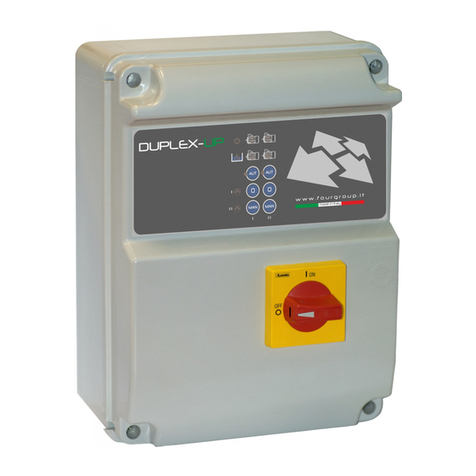
Fourgroup
Fourgroup DUPLEX-UP Use and installation guide
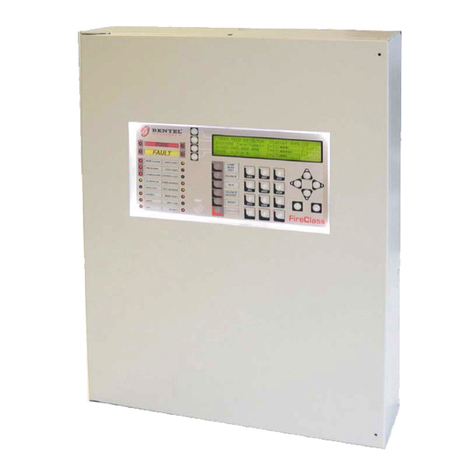
Bentel
Bentel FireClass FC500 user manual
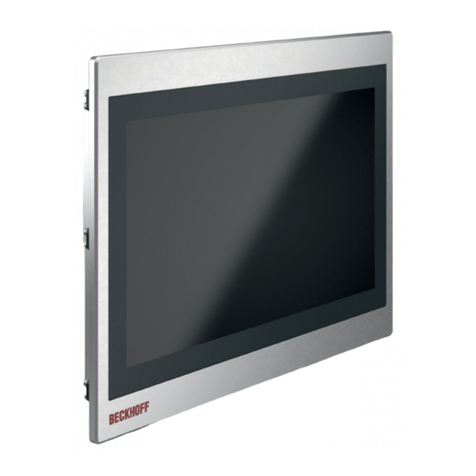
Beckhoff
Beckhoff CP29 -2 -0000 Series manual
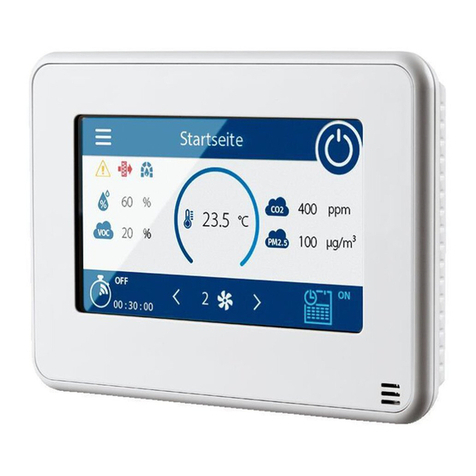
BLAUBERG Ventilatoren
BLAUBERG Ventilatoren S25 user manual
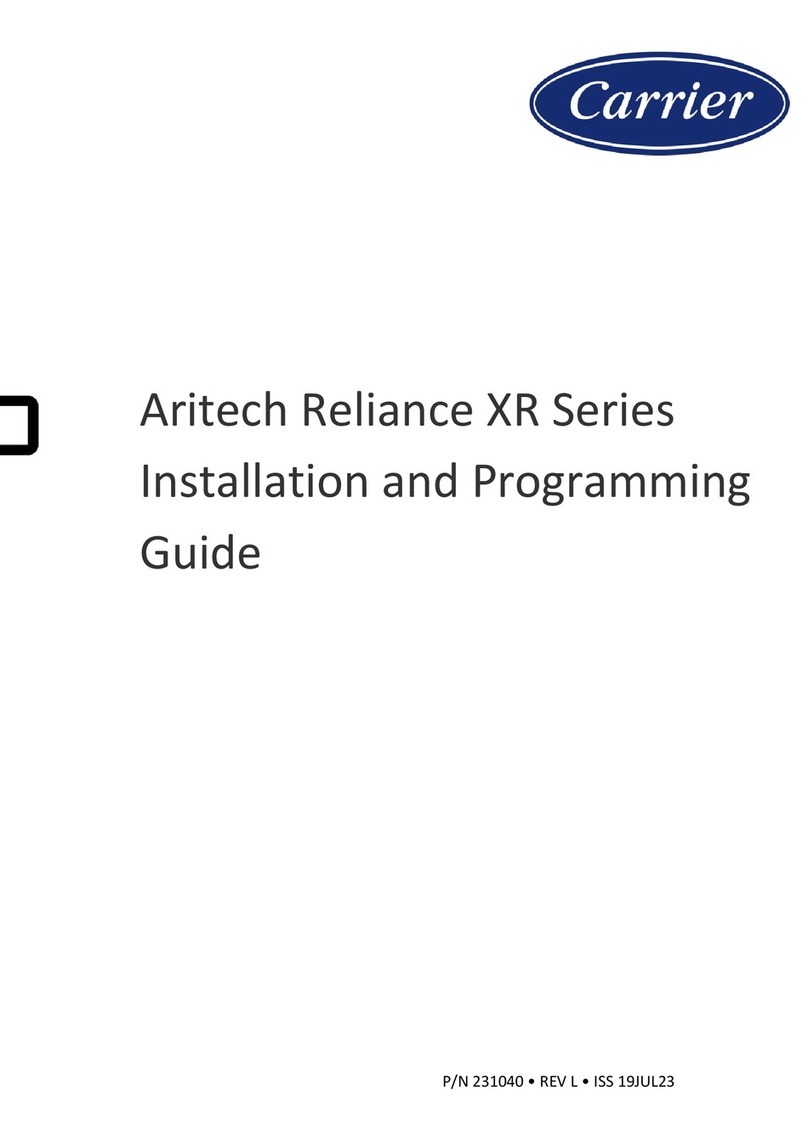
Carrier
Carrier Aritech Reliance XR Series Installation and programming guide
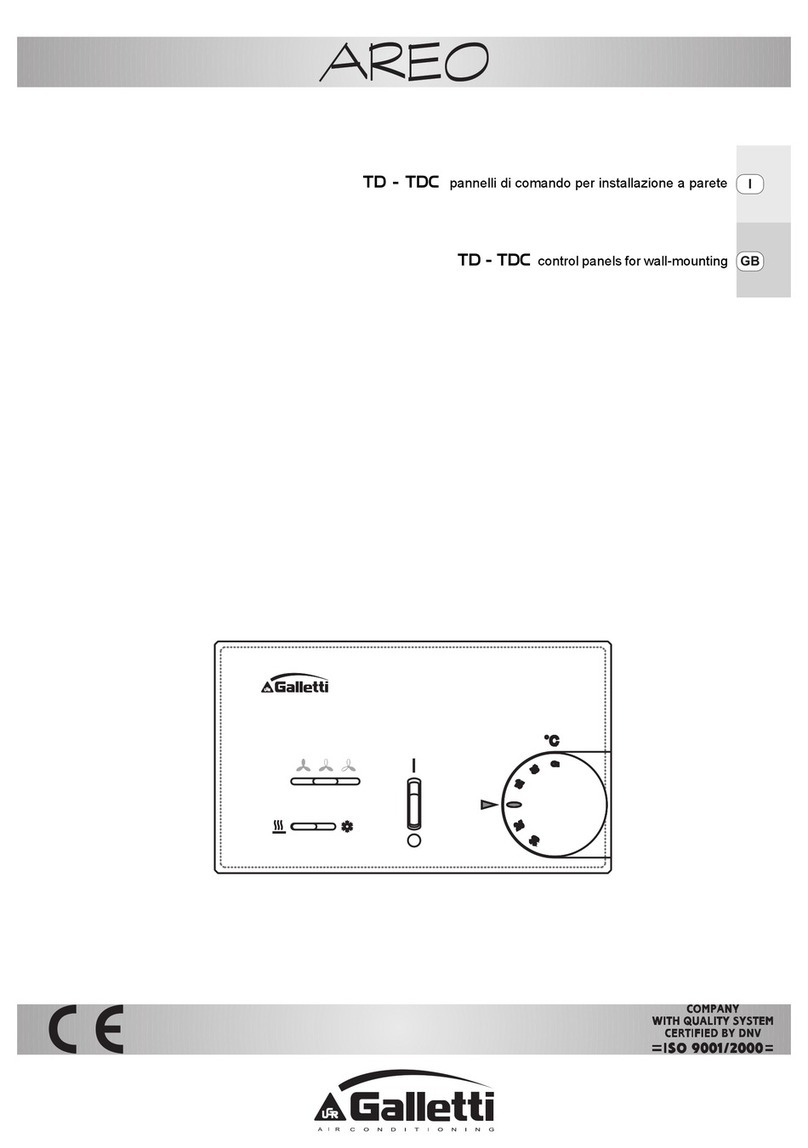
Galletti
Galletti AREO TD quick start guide
